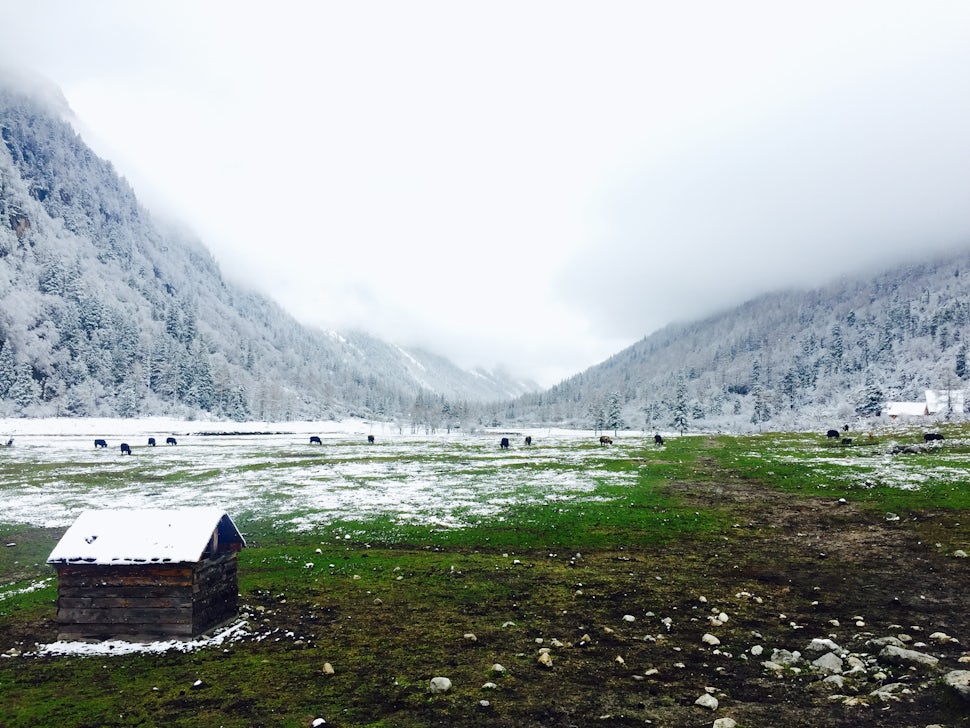Snowfall Among Giants in Tibetan China
The Changing Valley of the Siguniang Sanctuary proved that even the explored can be unexplored. On the edge of the Tibetan Plateau in a region of cultural variety, the mountains take prominence here. The locals revere them, the pandas abide in them, and international organizations have protected them. These are the Four Sisters Mountains of Amdo Tibet, know locally as Siguniangshan.

Located high on the edge of the Tibetan plateau, where driving east to west you experience dramatic changes in temperatures, cultures, food, and livestock, a series of mighty mountains greet you. These are called by the local Jyrong Tibetans as the Four Sisters Mountains, known in Chinese as Siguniangshan, because of four dramatic peaks lining nearly parallel to each other. The largest of these, aptly named the big sister, towers to an incredible 6,250 meters (20,500 feet). These mountains also lie parallel to two pristine valleys, the magical Changping Valley to the west and the wild Haizi Valley to the east. We were fortunate to traverse both valleys, each sharing different angles of the Four Sisters and each entirely unique.
We visited the Changping Valley of Siguniang National park at the end of April, but the weather suggested we were in the middle of winter. With morning temperatures below freezing and snow flurries falling the majority of the day, quite common in the highlands of Tibet where snow lasts until June, this created a surreal landscape. The trailhead to the valley starts around 5 km east of Changping Village, a modest village that serves great for overnight stays. A road served by a park shuttle bus transports you from the entrance of Changping Valley and the village. After walking through the entrance, we encounter a typical Tibetan Monastery, painted in Tibetan orange and white, and of course with hundreds of prayer flags flapping in the wind. Just beyond the picturesque Lama Monastery is the trail into the wonderland that is Changping Valley.
The trail into the valley is a newly constructed wooden path for half the distance (until when most people turn back) then turns into a typical dirt trail leading to Muluozi, a grassland for grazing Yaks that is dubbed a paradise for photographers. We set out early to reach Muluozi as it would entail at least 25 km (16 miles) of high elevation hiking. The valley is pure in its beauty. Every tree is covered by a fresh white powder and the fallen logs and plants are covered in a beautiful moss. Horses and yaks also make their home in these forests and are found grazing around every turn. Most impressively are the towering mountains that appear out of the snowy horizon every once in a while. This all leaves us breathless.
Around the halfway point to Muluozi we come across a shoal of dead trees, winding streams, and sandy beaches. On a clear day, this offers splendid views of the sisters, but we were forced to focus our attention on the foreground. This still did not disappoint. Unfortunately this marks the end of the road for most of the tourists who come to this valley. I would argue that Muluozi offers the most spectacular views though, but this entails a long walk of five or six kilometers on a muddy dirt path. Long gone is the wooden pathway. For most Chinese tourists, walking on a dirt path is not their idea of a fun vacation. In my mind, how could one make the difficult journey to these mountains but choose to turn back at the halfway mark?
Upon reaching Muluozi, our eyes are greeted with an open expanse of green grass littered with white snow, yaks grazing, and mountains piercing the horizons, extending beyond the clouds. A humble house built of timber is a home to several Tibetan nomads who keep watch over the yaks and horses. They invited us in to their living spaces, and the heat inside was a pleasant relief from the bitter winds outside. The valley surrounding here begs to be explored. The yaks are curious, but unwilling to let us get close. The river bends around the grassland, full of colors. But truly the dominant sight is the big sister. At 20,500 feet, we never even glimpsed its peak as the clouds engulfed her face, yet her elegance and beauty is mightily felt.
We want to acknowledge and thank the past, present, and future generations of all Native Nations and Indigenous Peoples whose ancestral lands we travel, explore, and play on. Always practice Leave No Trace ethics on your adventures and follow local regulations. Please explore responsibly!
Do you love the outdoors?
Yep, us too. That's why we send you the best local adventures, stories, and expert advice, right to your inbox.












